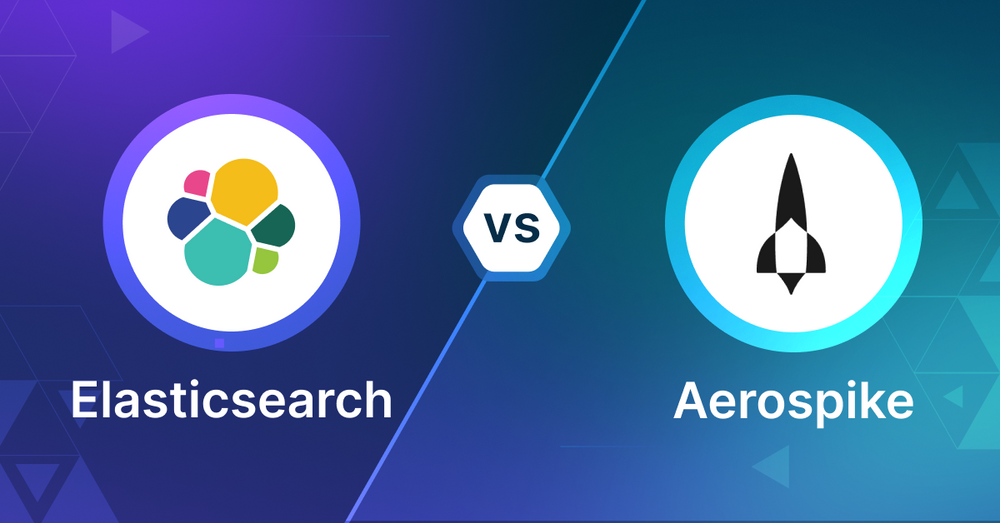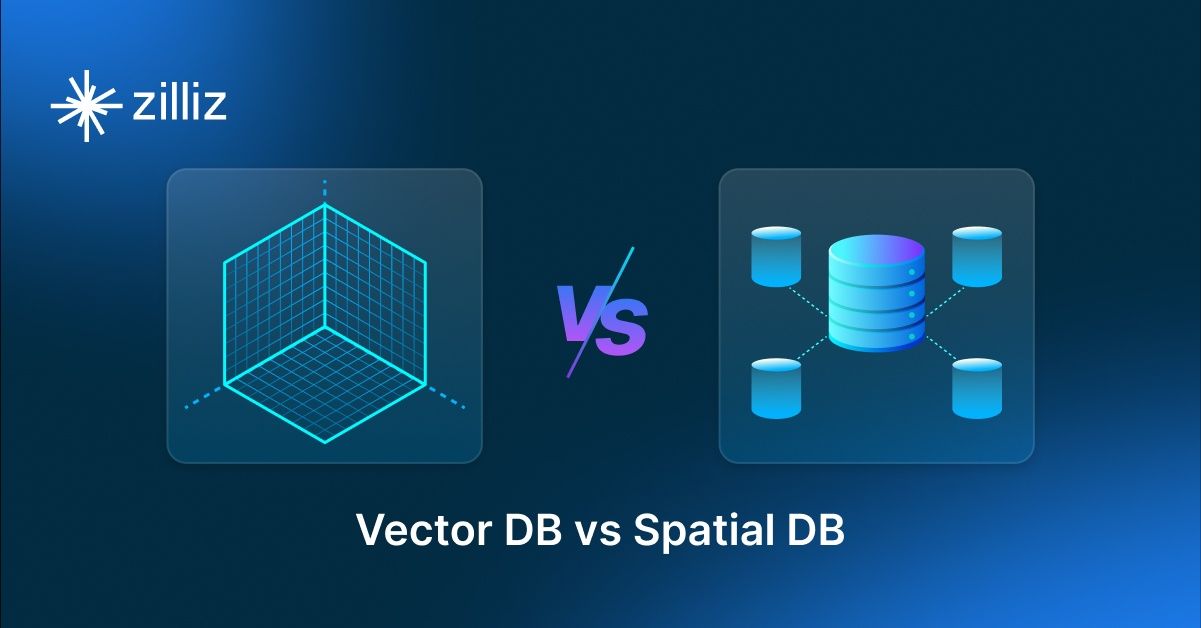Elasticsearch vs Aerospike: Selecting the Right Database for GenAI Applications

As AI-driven applications evolve, the importance of vector search capabilities in supporting these advancements cannot be overstated. This blog post will discuss two prominent databases with vector search capabilities: Elasticsearch and Aerospike. Each provides robust capabilities for handling vector search, an essential feature for applications such as recommendation engines, image retrieval, and semantic search. Our goal is to provide developers and engineers with a clear comparison, aiding in the decision of which database best aligns with their specific requirements.
What is a Vector Database?
Before we compare Elasticsearch vs Aerospike, let's first explore the concept of vector databases.
A vector database is specifically designed to store and query high-dimensional vectors, which are numerical representations of unstructured data. These vectors encode complex information, such as the semantic meaning of text, the visual features of images, or product attributes. By enabling efficient similarity searches, vector databases play a pivotal role in AI applications, allowing for more advanced data analysis and retrieval.
Common use cases for vector databases include e-commerce product recommendations, content discovery platforms, anomaly detection in cybersecurity, medical image analysis, and natural language processing (NLP) tasks. They also play a crucial role in Retrieval Augmented Generation (RAG), a technique that enhances the performance of large language models (LLMs) by providing external knowledge to reduce issues like AI hallucinations.
There are many types of vector databases available in the market, including:
- Purpose-built vector databases such as Milvus, Zilliz Cloud (fully managed Milvus)
- Vector search libraries such as Faiss and Annoy.
- Lightweight vector databases such as Chroma and Milvus Lite.
- Traditional databases with vector search add-ons capable of performing small-scale vector searches.
Elasticsearch is a search engine based on Apache Lucene and Aerospike is a distributed, scalable NoSQL database. Both have vector search capabilities as an add-on. This post compares their vector search capabilities.
Elasticsearch: Overview and Core Technology
Elasticsearch is an open source search engine built on top of the Apache Lucene library. It’s known for real time indexing and full text search so it’s a go to search for heavy applications and log analytics. Elasticsearch lets you search and analyse large amounts of data fast and efficiently.
Elasticsearch was built for search and analytics, with features like fuzzy searching, phrase matching and relevance ranking. It’s great for scenarios where complex search queries and real time data retrieval is required. With the rise of AI applications, Elasticsearch has added vector search capabilities so it can do similarity search and semantic search, which is required for AI use cases like image recognition, document retrieval and Generative AI.
Vector Search
Vector search is integrated in Elasticsearch through Apache Lucene. Lucene organises data into immutable segments that are merged periodically, vectors are added to the segments the same way as other data structures. The process involves buffering vectors in memory at index time, then serializing these buffers as part of segments when needed. Segments are merged periodically for optimization, and searches combine vector hits across all segments.
For vector indexing, Elasticsearch uses the HNSW (Hierarchical Navigable Small World) algorithm which creates a graph where similar vectors are connected to each other. This is chosen for its simplicity, strong benchmark performance and ability to handle incremental updates without requiring complete retraining of the index. The system performs vector searches typically in tens or hundreds of milliseconds, much faster than brute force approaches.
Elasticsearch’s technical architecture is one of its biggest strengths. The system supports lock free searching even during concurrent indexing and maintains strict consistency across different fields when updating documents. So if you update both vector and keyword fields, searches will see either all old values or all new values, data consistency is guaranteed. While the system can scale beyond available RAM, performance optimizes when vector data fits in memory.
Beyond the core vector search capabilities, Elasticsearch provides practical integration features that makes it super valuable. Vector searches can be combined with traditional Elasticsearch filters, so you can do hybrid search that mixes vector similarity with full text search results. The vector search is fully compatible with Elasticsearch’s security features, aggregations and index sorting, so it’s a complete solution for modern search use cases.
Aerospike: Overview and Core Technology
Aerospike is a NoSQL database for high-performance real-time applications. It has added support for vector indexing and searching so it’s suitable for vector database use cases. The vector capability is called Aerospike Vector Search (AVS) and is in Preview. You can request early access from Aerospike.
AVS only supports Hierarchical Navigable Small World (HNSW) indexes for vector search. When updates or inserts are made in AVS, record data including the vector is written to the Aerospike Database (ASDB) and is immediately visible. For indexing, each record must have at least one vector in the specified vector field of an index. You can have multiple vectors and indexes for a single record, so you can search for the same data in different ways. Aerospike recommends assigning upserted records to a specific set so you can monitor and operate on them.
AVS has a unique way of building the index, it’s concurrent across all AVS nodes. While vector record updates are written directly to ASDB, index records are processed asynchronously from an indexing queue. This is done in batches and distributed across all AVS nodes, so it uses all the CPU cores in the AVS cluster and is scalable. Ingestion performance is highly dependent on host memory and storage layer configuration.
For each item in the indexing queue, AVS processes the vector for indexing, builds the clusters for each vector and commits those to ASDB. An index record contains a copy of the vector itself and the clusters for that vector at a given layer of the HNSW graph. Indexing uses vector extensions (AVX) for single instruction, multiple data parallel processing.
AVS queries during ingestion to “pre-hydrate” the index cache because records in the clusters are interconnected. These queries are not counted as query requests but show up as reads against the storage layer. This way, the cache is populated with relevant data and can improve query performance. This shows how AVS handles vector data and builds indexes for similarity search so it can scale for high-dimensional vector searches.
Key Differences
Vector search is a must have for modern applications, from image recognition to AI powered document retrieval. If you are choosing between Elasticsearch and Aerospike for your vector search needs, this post will help you make an informed decision.
Search Architecture and Implementation
Elasticsearch is built on top of Apache Lucene, it organizes vector data into immutable segments that merge periodically. The system uses the HNSW (Hierarchical Navigable Small World) algorithm to create a graph where similar vectors connect. This allows searches to complete in tens to hundreds of milliseconds.
Aerospike’s vector search capability, called Aerospike Vector Search (AVS) is in Preview. Like Elasticsearch it uses HNSW indexes but indexes differently. AVS processes vectors asynchronously across all nodes in the cluster, uses vector extensions (AVX) for parallel processing.
Data Management and Consistency
Elasticsearch enforces strict consistency across all fields when updating documents. When you update both vector and keyword fields, searches will see either all old values or all new values, never a mix. The system allows lock free searching during concurrent indexing.
Aerospike handles data updates differently. When records are updated or inserted the vector data writes immediately to the Aerospike Database (ASDB). However index records are processed asynchronously from an indexing queue, distributed in batches across AVS nodes.
Performance and Scalability
Elasticsearch performs best when vector data fits in memory, but can scale beyond available RAM. Its architecture allows for real-time indexing and full-text search.
Aerospike’s performance depends on host memory and storage layer configuration. Its distributed indexing uses all CPU cores in the AVS cluster. The system pre-hydrates the index cache through background queries which can improve query performance.
Integration and Additional Features
Elasticsearch is strong in its integrations. You can combine vector searches with traditional filters to do hybrid search that mixes vector similarity with full-text search results. The vector search works seamlessly with Elasticsearch’s security features, aggregations and index sorting.
Aerospike allows multiple vectors and indexes per record, gives you flexibility in how you search your data. The system recommends to assign upserted records to specific sets for easier monitoring and operations.
Limitations and Considerations
Elasticsearch’s vector search is a mature feature built into the core. However, performance requires careful memory management and system configuration.
AVS is in Preview, contact Aerospike to get early access. Distributed indexing gives scalability but preview means there may be limitations and changes in future releases.
When to Use Each
Use Elasticsearch when you need a production ready vector search solution that combines with full text search. It’s perfect for applications that need hybrid search functionality, e.g. e-commerce platforms that use both keyword and similarity search, content recommendation systems or AI powered document retrieval systems where data consistency and mature security features are important. It’s particularly good when you have the memory to optimise performance and need to integrate with existing search infrastructure.
Use Aerospike when you’re building a system that needs distributed processing power and can handle a preview status vector search implementation. It’s good for applications that benefit from asynchronous indexing and parallel processing across nodes, e.g. high throughput data ingestion systems or applications where you need flexible vector indexing options. It’s best when you can use its distributed architecture and don’t need to deploy vector search into production immediately.
Conclusion
The choice between Elasticsearch and Aerospike comes down to your technical requirements and project timeline. Elasticsearch has a mature, well integrated vector search solution with proven hybrid search capabilities and a strong ecosystem, so it’s the safer choice for immediate production needs. Aerospike has powerful distributed processing and flexible vector indexing options but is in preview so you’ll need to consider the limitations and changes in future releases. Your decision should weigh up existing infrastructure, data consistency requirements, processing needs and whether you need to deploy into production immediately or can work with preview features while you build your system.
Read this to get an overview of Elasticsearch and Aerospike but to evaluate these you need to evaluate based on your use case. One tool that can help with that is VectorDBBench, an open-source benchmarking tool for vector database comparison. In the end, thorough benchmarking with your own datasets and query patterns will be key to making a decision between these two powerful but different approaches to vector search in distributed database systems.
Using Open-source VectorDBBench to Evaluate and Compare Vector Databases on Your Own
VectorDBBench is an open-source benchmarking tool for users who need high-performance data storage and retrieval systems, especially vector databases. This tool allows users to test and compare different vector database systems like Milvus and Zilliz Cloud (the managed Milvus) using their own datasets and find the one that fits their use cases. With VectorDBBench, users can make decisions based on actual vector database performance rather than marketing claims or hearsay.
VectorDBBench is written in Python and licensed under the MIT open-source license, meaning anyone can freely use, modify, and distribute it. The tool is actively maintained by a community of developers committed to improving its features and performance.
Download VectorDBBench from its GitHub repository to reproduce our benchmark results or obtain performance results on your own datasets.
Take a quick look at the performance of mainstream vector databases on the VectorDBBench Leaderboard.
Read the following blogs to learn more about vector database evaluation.
Further Resources about VectorDB, GenAI, and ML
- What is a Vector Database?
- Elasticsearch: Overview and Core Technology
- Aerospike: Overview and Core Technology
- Key Differences
- Search Architecture and Implementation
- Data Management and Consistency
- Performance and Scalability
- Integration and Additional Features
- Limitations and Considerations
- When to Use Each
- Conclusion
- Using Open-source VectorDBBench to Evaluate and Compare Vector Databases on Your Own
- Further Resources about VectorDB, GenAI, and ML
Content
Start Free, Scale Easily
Try the fully-managed vector database built for your GenAI applications.
Try Zilliz Cloud for FreeKeep Reading

The Real Bottlenecks in Autonomous Driving — And How AI Infrastructure Can Solve Them
Autonomous driving is data-bound. Vector databases unlock deep insights from massive AV data, slashing costs and accelerating edge-case discovery.

Zilliz Cloud Introduces Advanced BYOC-I Solution for Ultimate Enterprise Data Sovereignty
Explore Zilliz Cloud BYOC-I, the solution that balances AI innovation with data control, enabling secure deployments in finance, healthcare, and education sectors.

Vector Databases vs. Spatial Databases
Use a vector database for AI-powered similarity search; use a spatial database for geographic and geometric data analysis and querying.
The Definitive Guide to Choosing a Vector Database
Overwhelmed by all the options? Learn key features to look for & how to evaluate with your own data. Choose with confidence.